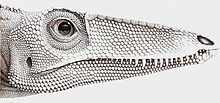- Megapnosaurus
-
Megapnosaurus
Temporal range: 199–188 Ma Early Jurassic
An artist's depiction of Megapnosaurus kayentakatae feeding on Scutellosaurus Scientific classification Kingdom: Animalia Phylum: Chordata Class: Sauropsida Superorder: Dinosauria Order: Saurischia Suborder: Theropoda Family: Coelophysidae Genus: Megapnosaurus
Ivie, Ślipiński & Węgrzynowicz, 2001Species M. rhodesiensis (Raath, 1969 [originally Syntarsus]) (type)
M. kayentakatae (Rowe, 1989 [originally Syntarsus])Synonyms Syntarsus Raath, 1969 (preoccupied by Fairmaire, 1869)
Megapnosaurus (meaning "big dead lizard", from Greek μεγα = "big", 'απνοος = "not breathing", "dead", σαυρος = "lizard") was a dinosaur of the theropod family Coelophysidae, formerly called Syntarsus (named by Raath, 1969), living during the Early Jurassic. It was renamed by American entomologist Dr. Michael Ivie (Montana State University of Bozeman), Polish Australian Dr. Adam Ślipiński, and Polish Dr. Piotr Węgrzynowicz (Muzeum Ewolucji Instytutu Zoologii PAN of Warsaw), the scientists who discovered that the genus name Syntarsus was already taken by a colydiine beetle described in 1869. It was one of the first dinosaurs to be portrayed with feathers, although it and other coelophysoids probably lacked them.
Contents
History
Some paleontologists did not like the naming of Megapnosaurus, partially because taxonomists are generally expected to allow original authors of a name to correct any mistakes in their work. Raath was aware of the homonymy between the dinosaur Syntarsus and beetle Syntarsus, but the group who published Megapnosaurus had been led to believe Raath was deceased and proceeded accordingly. Megapnosaurus remains the valid name for the fossil material.
It is almost identical to Coelophysis, and Yates (2005) suggested that Megapnosaurus was possibly synonymous with Coelophysis.[1] In 2004, Raath co-authored two papers in which he argued that Syntarsus was a junior synonym of Coelophysis.
Description
Megapnosaurus measured up to 3 meters (10 ft) long from nose to tail and weighed about 32 kilograms (70 lb). The bones of 30 Megapnosaurus individuals were found together in a fossil bed in Zimbabwe, so paleontologists think it may have hunted in packs. The various fossils attributed to Megapnosaurus have been dated over a relatively large time span - the Hettangian, Sinemurian, and Pliensbachian stages of the Early Jurassic - meaning the fossils represent either a highly successful genus or a few closely related animals all currently assigned to Megapnosaurus.
Megapnosaurus is a good example of how dinosaurs spread across the globe from their ancestral habitats (which was possibly South America). This small predator had the same basic features found in early dinosaurs, and its appearance in both Africa and the southwestern U.S. indicates that it migrated through the continents, which at the time were joined together as Pangaea. There is species-level differentiation between the African and U.S. specimens, again supporting the migration and adaptation theories.
The African species (M. rhodesiensis) is known from almost 30 specimens. The North American species (M. kayentakatae) had small crests and may show an evolutionary step toward later and larger coelophysoids, such as the more derived Dilophosaurus. Both possess a weak joint between the premaxillary and the maxillary bones, creating a hooked premaxillary jaw. This led to the early hypothesis that dinosaurs such as these were scavengers, as the front teeth and bone structure were thought to be too weak to take down and hold struggling prey.
Age determination studies using growth ring counts suggest that the longevity of Megapnosaurus was approximately seven years.[2]
Comparisons between the scleral rings of Megapnosaurus and modern birds and reptiles indicate that it may have been nocturnal.[3]
In Syntarsus rhodesiensis healed fractures of the tibia and metatarsus have been observed, but are very rare. "[T]he supporting butresses of the second sacral rib" in one specimen of Syntarsus rhodesiensis showed signs of fluctuating asymmetry. Fluctuating asymmetry results from developmental disturbances and is more common in populations under stress and can therefore be informative about the quality of conditions a dinosaur lived under.[4]
In popular culture
In When Dinosaurs Roamed America, a pack of Megapnosaurus (referred to as Syntarsus) attack an Anchisaurus, only to be scared off by a Dilophosaurus.
References
- ^ Yates, A.M. (2005). "A new theropod dinosaur from the Early Jurassic of South Africa and its implications for the early evolution of theropods". Palaeontologia Africana 41:105-122
- ^ Chinsamy, A. (1994). Dinosaur bone histology: Implications and inferences. In Dino Fest (G. D. Rosenburg and D. L. Wolberg, Eds.), pp. 213-227. The Palentological Society, Department of Geological Sciences, Univ. of Tennessee, Knoxville.
- ^ Schmitz, L.; Motani, R. (2011). "Nocturnality in Dinosaurs Inferred from Scleral Ring and Orbit Morphology". Science in press. doi:10.1126/science.1200043. PMID 21493820.
- ^ Molnar, R. E., 2001, Theropod paleopathology: a literature survey: In: Mesozoic Vertebrate Life, edited by Tanke, D. H., and Carpenter, K., Indiana University Press, p. 337-363.
- Bristowe, A. & M.A. Raath (2004). "A juvenile coelophysoid skull from the Early Jurassic of Zimbabwe, and the synonymy of Coelophysis and Syntarsus." Palaeont. Afr., 40: 31-41.
- Bristowe, A., A. Parrott, J. Hack, M. Pencharz & M. Raath (2004). "A non-destructive investigation of the skull of the small theropod dinosaur, Coelophysis rhodesiensis, using CT scans and rapid prototyping." Palaeont. Afr. 40: 159-163.
- Ivie, M. A., S. A. Ślipiński, and P. Węgrzynowicz (2001). "Generic homonyms in the Colydiinae (Coleoptera: Zopheridae)." Insecta Mudi, 15:63-64.
- Raath (1969). "A new Coelurosaurian dinosaur from the Forest Sandstone of Rhodesia." Arnoldia Rhodesia. 4 (28): 1-25.
Categories:- Coelophysoids
- Dinosaurs of Africa
- Dinosaurs of North America
- Jurassic dinosaurs
- Geology of Zimbabwe
Wikimedia Foundation. 2010.

